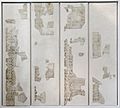Roman calendar facts for kids
The Roman calendar was a way the ancient Roman Kingdom and later the Roman Republic kept track of time. It was based on the Moon's cycles.
Contents
How the Roman Calendar Worked
The Early Calendar
The very first Roman calendar started on March 1st. It had only 10 months and 304 days. These months were March, April, May, June, Quintilis, Sextilis, September, October, November, and December. After these 304 days, there was a period of about 50 days in winter that didn't have names.
Adding More Months
Later, a Roman king named Numa Pompilius (who lived around 715-673 BC) added two new months: February and January. He put them between December and March. This made the year longer, with about 354 or 355 days. Around 450 BC, February was moved to where it is now, between January and March.
Fixing the Calendar with Extra Days
To make the calendar match the actual length of a year better, an extra month was sometimes added. This extra month was called Intercalaris or Mercedonius. It usually had 22 or 23 days.
Here's how the length of the years changed over an 8-year period:
- Year 1: 12 months or 355 days
- Year 2: 13 months or 377 days (with an extra month)
- Year 3: 12 months or 355 days
- Year 4: 13 months or 378 days (with an extra month)
- Year 5: 12 months or 355 days
- Year 6: 13 months or 377 days (with an extra month)
- Year 7: 12 months or 355 days
- Year 8: 13 months or 378 days (with an extra month)
If you added up all the days over these 8 years, it came to 2930 days. This meant the average year was about 366¼ days long. However, this was still a bit too long. So, later on, 7 days were removed from the 8th year. This made the average year about 365.375 days long, which is much closer to the real length of a year.
Problems and Reforms
It was the job of the priests to make sure these extra months were added correctly. But sometimes, they didn't do it right. Also, adding an extra month (a "leap year") was thought to bring bad luck. So, during tough times, like the Second Punic War, they would sometimes avoid adding the extra month. This made the calendar get out of sync with the seasons.
To fix these problems, Julius Caesar made big changes to the calendar in 45 BC. This new calendar is known as the Julian calendar, and it was a major improvement!
Images for kids
See also
 In Spanish: Calendario romano para niños
In Spanish: Calendario romano para niños





